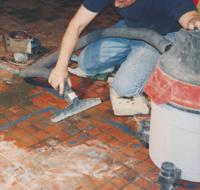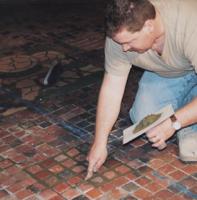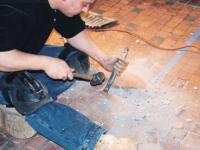Moravian Tile MaintenanceWhen Henry Chapman Mercer produced the 16,000-square-foot Moravian tile floor for the Capitol building, he set out to express the story of Pennsylvania's rich history — from contact with Native Americans through the state's industrial might. "It is the life of the people," he wrote, "rough, powerful, and absolutely real . . ." No other singular artistic creation tells the story of Pennsylvania's history in the original style of Mercer's work, but it is doubtful that Mercer could foresee the amount of wear to his masterpiece of American folk art. Some 94 years after it was completed, the Moravian tile floor requires constant maintenance to preserve its integrity and appearance. The basis for this unique style of floor comes from Mercer's concern for the dying craft tradition of the Pennsylvania German potter. Seeing this trade rapidly disappearing, Mercer sought to produce tiles that combined various methods of production. He believed the tiles should be handmade using local clay, yet able to be produced in quantities large enough to make them affordable. There are two basic types of tiles present in the Capitol floor: field tiles — the square background tiles that are various shades of reds, oranges, and darker colors; and mosaics — the individually hand-cut tiles that make the "pictures" in the floor. Each original tile has the Tile Works logo and a number stamped on the bottom; but over the years, some tiles have been moved or replaced to mitigate the harmful effects of time. Over the years, there have been repeated efforts to reduce harm to the tile floor. Beginning in the 1930s, Works Progress Administration (WPA) artisans made significant additions to certain areas of the floor, replacing many field tiles that were damaged by traffic. Subsequent repairs were periodically made to the floor as the years progressed. Through the 1980s, the Preservation Committee conducted periodic replacement of broken tiles, and beginning in 1998 the Capitol Preservation Committee began a project of cleaning and conserving the tile floor. This project entailed removal of the old wax coatings, replacement of worn or damaged tiles, repair of weathered or discolored grout joints, and the application of new wax coatings to protect the work. Between 1998 and 2000, the Committee's ongoing project has maintained, repaired, and reproduced tiles that were manufactured at Mercer's own Moravian Tile Factory in Doylestown, Pennsylvania. Using a computer-generated floor map, the Committee surveyed damaged areas and established specific maintenance practices tailored to suit each area. High damage areas were divided into sectors, and tiles that were severely pitted, recessed, or that posed a safety hazard were replaced. The remaining areas of the floor, though minimally damaged, still had years' worth of dirt and wax buildup. Cleaning the floors involved using mild wax removers, followed by a thorough washing. Protective sealer was then applied to the entire floor. Several clear coats of wax provided protective layers acting as barriers to dirt, grime, and daily use. While the mosaics in the north wing of the building were showing slight wear, the grout around many of them was unstable due to moisture and de-icing salts from nearby doorways. Within the rotunda, specific mosaics showing signs of damage were targeted for grout repair, and recessed field tiles were replaced both there and in the main entranceway. The majority of tile maintenance, however, was located within the south wing, which sees the hardest use because of its proximity to parking garages and Capitol Park. The Moravian tile floor is considered one of the most unique public walkways in America. It requires constant maintenance against the contributing effects of moisture, weather, traffic, and everyday use. The Committee is committed to ensuring that this exceptional work of art is preserved for future generations, and that Henry Mercer's remarkable tile floor will continue to express the history of Pennsylvania,. |
VACUUMING WATER FROM WET
GROUTING IN NEW
REMOVAL OF INDIVIDUAL WORN |


